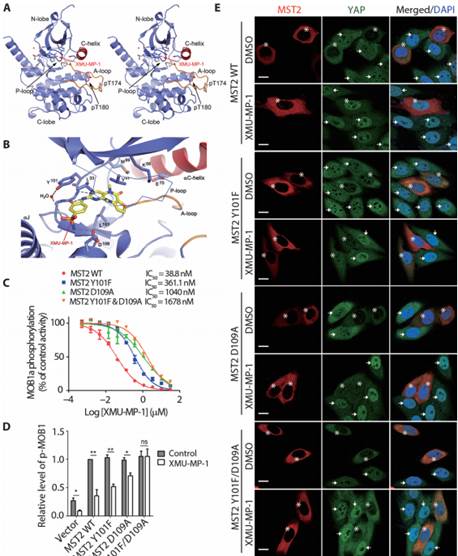


中国研究人员17日说,一种小分子药物会促进受损的肝脏修复与再生,并在小鼠实验中取得了优异的治疗效果。
这项研究发表在新一期美国《科学转化医学》杂志上。研究负责人之一、厦门大学生命科学学院副院长周大旺教授对新华社记者说,以往促进组织修复与再生方面的研究更多关注把生物材料递送至特定位置的复杂治疗策略,而本研究成果表明,单纯运用小分子药物也可望用于促进肝脏的修复与再生。
周大旺与厦大的邓贤明教授及北京大学的云彩红教授等人的研究针对可调控器官再生与尺寸大小的Hippo信号通路。之前的研究显示,此信号通路中有一种叫Mst1/2的关键蛋白激酶阻止包括肝脏在内的多个组织持续再生,因此他们希望开发抑制这种蛋白激酶的药物,并最终找到了一种小分子抑制剂,取名为XMU-MP-1,属于化学药。
他们的研究显示,这种药物不仅在蛋白和细胞水平取得了显著活性,还在肝叶片切除、药物泰诺引起的急性肝损伤等多个小鼠体内组织损伤模型中取得了优异的治疗效果,能有效提高肝脏再生初始阶段的速率,显著降低急性肝损伤的致死率等。
除了肝脏外,这种药物也可望用于肠道的修复与再生。
研究人员说,本项研究是激酶靶向药物在促进组织再生和修复治疗领域的新探索,已得到部分制药公司的关注,正在接洽相关合作事宜。(来源:新华社 记者林小春)
Pharmacological targeting of kinases MST1 and MST2 augments tissue repair and regeneration
Abstract Tissue repair and regenerative medicine address the important medical needs to replace damaged tissue with functional tissue. Most regenerative medicine strategies have focused on delivering biomaterials and cells, yet there is the untapped potential for drug-induced regeneration with good specificity and safety profiles. The Hippo pathway is a key regulator of organ size and regeneration by inhibiting cell proliferation and promoting apoptosis. Kinases MST1 and MST2 (MST1/2), the mammalian Hippo orthologs, are central components of this pathway and are, therefore, strong target candidates for pharmacologically induced tissue regeneration. We report the discovery of a reversible and selective MST1/2 inhibitor, 4-((5,10-dimethyl-6-oxo-6,10-dihydro-5H-pyrimido[5,4-b]thieno[3,2-e][1,4]diazepin-2-yl)amino)benzenesulfonamide (XMU-MP-1), using an enzyme-linked immunosorbent assay–based high-throughput biochemical assay. The cocrystal structure and the structure-activity relationship confirmed that XMU-MP-1 is on-target to MST1/2. XMU-MP-1 blocked MST1/2 kinase activities, thereby activating the downstream effector Yes-associated protein and promoting cell growth. XMU-MP-1 displayed excellent in vivo pharmacokinetics and was able to augment mouse intestinal repair, as well as liver repair and regeneration, in both acute and chronic liver injury mouse models at a dose of 1 to 3 mg/kg via intraperitoneal injection. XMU-MP-1 treatment exhibited substantially greater repopulation rate of human hepatocytes in theFah-deficient mouse model than in the vehicle-treated control, indicating that XMU-MP-1 treatment might facilitate human liver regeneration. Thus, the pharmacological modulation of MST1/2 kinase activities provides a novel approach to potentiate tissue repair and regeneration, with XMU-MP-1 as the first lead for the development of targeted regenerative therapeutics.
原文链接:http://stm.sciencemag.org/content/8/352/352ra108.full.pdf+html



